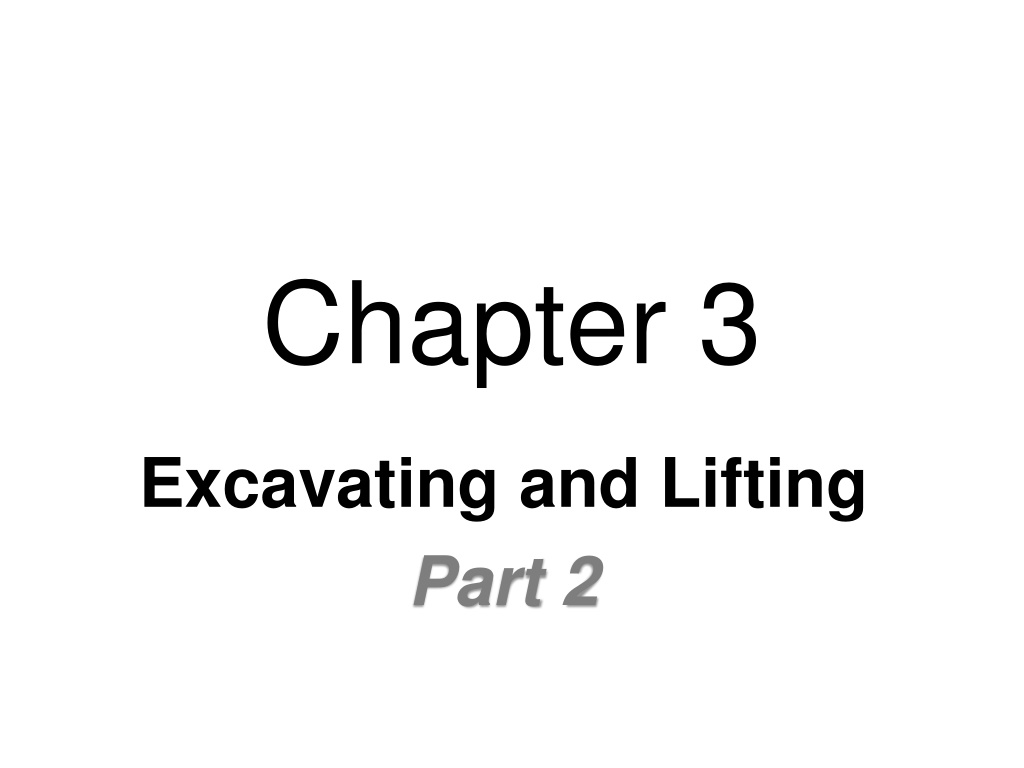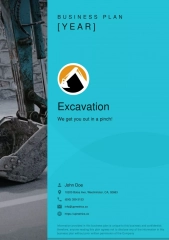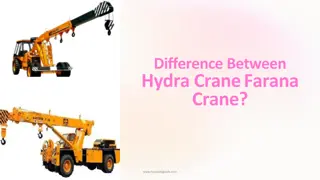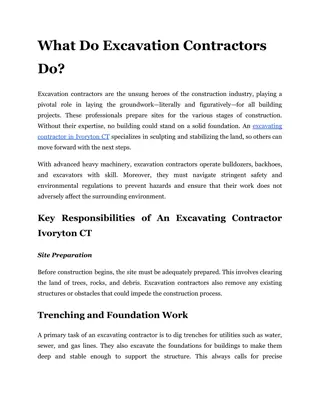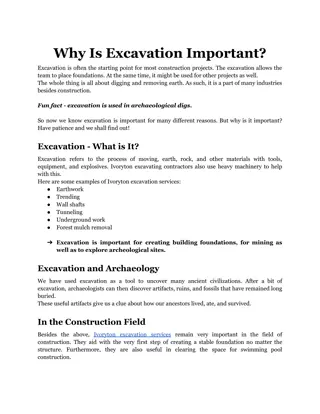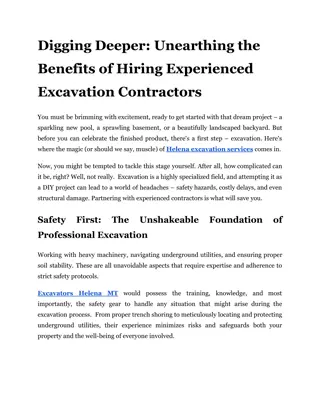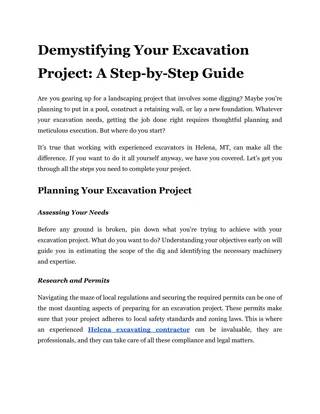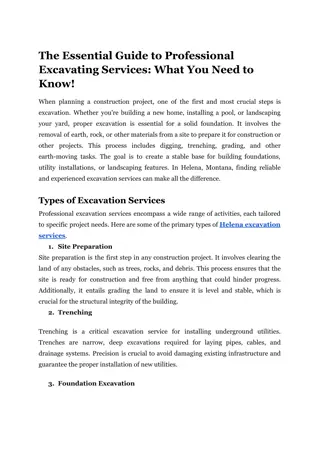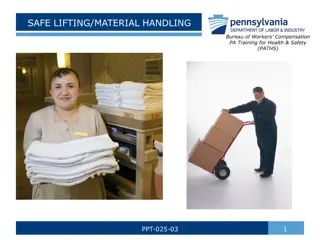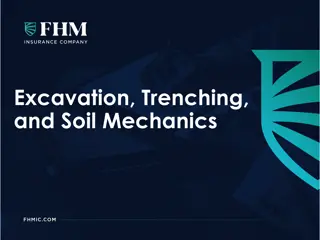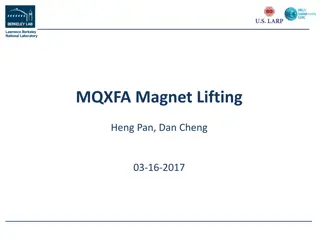Understanding Draglines: Excavation and Lifting Insights
Explore the versatile capabilities of dragline machines in excavation and lifting operations. Learn about their components, digging actions, and considerations for optimal performance. Discover how to estimate dragline production accurately for efficient job management.
Download Presentation

Please find below an Image/Link to download the presentation.
The content on the website is provided AS IS for your information and personal use only. It may not be sold, licensed, or shared on other websites without obtaining consent from the author. Download presentation by click this link. If you encounter any issues during the download, it is possible that the publisher has removed the file from their server.
E N D
Presentation Transcript
Chapter 3 Excavating and Lifting Part 2
3-4 DRAGLINES Operation and Employment Production Estimating Job Management
Operation and Employment The dragline : It is a very versatile machine that has the longest reach for digging and dumping of any member of the crane-shovel family. It can dig from above machine level to significant depths in soft to medium-hard material. The components of a dragline are shown in Figure 3-10.
3-4 DRAGLINES Bucket teeth and weight produce digging action as the drag cable pulls the bucket across the ground surface. Digging is also controlled by the position at which the drag chain is attached to the bucket (Figure 3-11).
3-4 DRAGLINES It is a very versatile excavator, it does not have the positive digging action or lateral control of the shovel. Because of that: the bucket may bounce or move sideways during hard digging. More spillage must be expected in loading than would occur with a shovel.
3-4 DRAGLINES The maximum bucket size to be used on a dragline depends on machine power, boom length, and material weight. Therefore, use the dragline capacity chart provided by the manufacturer instead of the machine's lifting capacity chart to determine maximum allowable bucket size.
3-4 DRAGLINES To estimate dragline production using the tables, determine the ideal output of the dragline for the machine size and material (Table 3-7), then adjust this figure by multiplying it by a swing- depth factor (Table 3-9) and a job efficiency factor, as shown in Equation 3-3. Expected production = Ideal output Swing-depth factor Efficiency Notice the conditions applicable to Table 3-7 given in the footnote.. (3-3)
3-4 DRAGLINES To use Table 3-9, it is first necessary to determine the optimum depth of cut for the machine and material involved from Table 3-8. Next, divide the actual depth of cut by the optimum depth and express the result as a percentage.
3-4 DRAGLINES The appropriate swing-depth factor is then obtained from Table 3-9, interpolating as necessary. The method of calculating expected hourly production is illustrated in Example 3-4.
EXAMPLE 3-4 Determine the expected dragline production in loose cubic yards (LCM) per hour based on the following information. Dragline size = 2 cu yd (1.53 m3) Swing angle = 120o Average depth of cut = 7.9 ft (2.4 m) Material = common earth Job efficiency = 50 min/h Soil swell = 25%
EXAMPLE 3-4 Solution Ideal output =230 BCY/h (176 BCM/h) (Table 3-7) Optimum depth of cut = 9.9 ft (3.0 m) (Table 3-8) Actual depth/optimum depth = 7.9/9.9 100 = 80% [= 2.4/3.0 100 = 80%]
EXAMPLE 3-4 Swing-depth factor=0.90 (Table 3-9) Efficiency factor =50/60 = 0.833 Volume change factor = 1 + 0.25 = 1.25 Estimated production = 230 0.90 0.833 1.25 = 216 LCY/h [= 176 0.90 0.833 1.25 = 165 LCM/h]
Job Management Trial operations may be necessary to select: the boom length, boom angle, bucket size and weight, and the attachment position of the drag chain that yield maximum production. As in shovel operation, maximum production is obtained with a minimum swing angle.
Job Management Special bucket hitches are available which shorten the drag distance necessary to obtain a full bucket load. Deep cuts should be excavated in layers whose thickness is as close to the optimum depth of cut as possible.
3-5 CLAMSHELLS Operation and Employment Production Estimating Job Management
3-5 CLAMSHELLS Operation and Employment When the crane-shovel is equipped with a crane boom and clamshell bucket, it becomes an excavator known as a clamshell. The clamshell is capable of excavating to great depths. The shovel and backhoe is better than clamshell because of : lacks the positive digging action and precise lateral control.
3-5 CLAMSHELLS Clamshells are commonly used for: excavating vertical shafts and footings, unloading bulk materials from rail cars and ships, and moving bulk material from stockpiles to bins, hoppers, or haul units.
3-5 CLAMSHELLS Bucket penetration depends on bucket weight assisted by the bucket teeth. Therefore, buckets are available in light, medium, and heavy weights, with and without teeth. 1. Heavy buckets: are suitable for digging medium soils. 2. Medium buckets: are used for general-purpose work, including the excavation of loose soils. 3. Light buckets: are used for handling bulk materials such as sand and gravel.
3-5 CLAMSHELLS The orange peel bucket illustrated in Figure 3-15 is principally utilized for underwater excavation and for rock placement. Because of its circular shape, it is also well suited to excavating piers and shafts. It operates on the same principle as does the clamshell.
FIGURE 3-15: Orange peel bucket. (Courtesy of ESCO Corporation)
3-5 CLAMSHELLS Production Estimating No standard production tables are available for the clamshell. Thus production estimation should be based on the use of Equation 2-1. The procedure is illustrated in Example 3-5.
EXAMPLE 3-5 Estimate the production in loose cubic yards per hour for a medium-weight clamshell excavating loose earth. Heaped bucket capacity is 1 cu yd (0.75 m3). The soil is common earth with a bucket fill factor of 0.95. Estimated cycle time is 40 s. Job efficiency is estimated at 50 min/h.
EXAMPLE 3-5 Solution Production = 3600/40 1 0.95 60/50 = 71 LCY/h B = 3600/40 0.75 0.95 60/50 = 53 LCM/h
Job Management The maximum allowable load (bucket weight plus soil weight) on a clamshell should be obtained from the manufacturer's clamshell loading chart for continuous operation.
Job Management limit the load to 80% of the safe lifting capacity given by the crane capacity chart for rubber- tired equipment or 90% for crawler-mounted equipment. use of the lightest bucket capable of digging the material will enable a larger bucket to be used and will usually increase production.
Job Management Cycle time is reduced by organizing the job so that the dumping radius is the same as the digging radius. Keep the machine level to avoid swinging uphill or downhill. Nonlevel swinging is hard on the machine and usually increases cycle time.
